Kothari D.P., Nagrath I.J. Modern Power Systems Analysis
Подождите немного. Документ загружается.

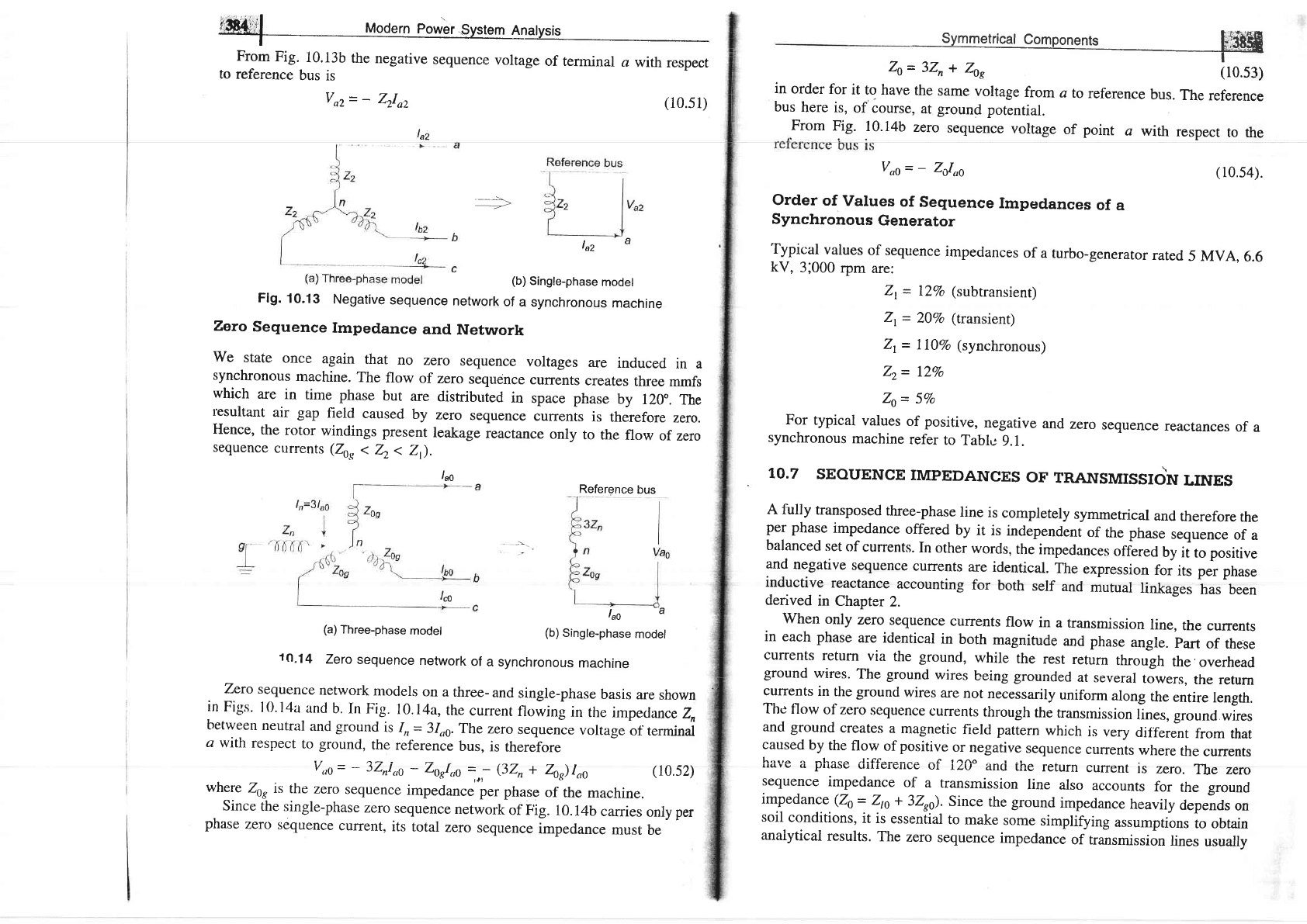
fl$4.:rl
Mooern
powLr
System nnarysis
t-
From
Fig'
10.13b
the
negative
sequence
voltage
of terminal
a
with
respecr
to
reference
bus
is
Voz=
-
Zzloz
symmetricat
Components
FjSiffi
Zs=
3Zra
Zos
(10.53)
in
order
for
it
to have
the
same
voltage
from
a
to
reference
bus.
The
reference
bus
here
is,
of course,
at
ground
potential.
From
Fig.
10.14b
zero
sequence
voltage
of point
c
with
respect
to
the
Voo
=
-
Z{oo
(10.54).
Order
of
Values
of
Sequence
Impedances
of
a
Synchronous
Generator
Typical
values
of sequence
impedances
of
a
turbo-generator
rated
5 MVA,
6.6
kV,
3;000
rpm
are:
Zr
=
lZ%o
(subtransient)
Zr
=
20Vo
(transient)
Zr
=
7l0Vo (synchronous)
Zz=
I2Vo
Zo=
5Vo
For
typical
values
of positive,
negative
and
zero
sequence
reactances
of
a
synchronous
machine
refer
to
Tablu
9.1.
IO.7
SEOUENCE
IMPEDANCES
OF
TRANSMISSIO\
LINES
A
fully
transposed
three-phase
line
is
completely
symmetrical
and
therefore
the
per
phase
impedance
offered
by
it
is
independent
of
the phase
sequence
of
a
balanced
set
of
currents.
In
other
words,
the
impedances
offired
by
ii
to positive
and
negative
sequence
culrents
are
identical.
The
expression
foi
its
per phase
inductive
reactance
accounting
for
both
self
and
mutual
linkages
ias been
derived
in
Chapter
2.
When
only
zero
sequence
currents
flow
in
a
transmission
line,
the
currents
in
each phase
are identical
in
both
magnitude
and
phase
angle.
part
of these
currents
return
via
the ground,
while
the
rest
return
throu
h
the
overhead
ground
wires.
The
ground
wires
being grounded
at
several
towers,
the return
currents
in
the
ground
wires
are
not
necessarily
uniform
along
the
entire
length.
The
flow
of zero
sequence
currents
through
the
transrnission
iln"r,
ground
wires
and ground
creates
a
magnetic
field pattern
which
is
very
different
from
that
caused
by
the
flow
of
positive
or
negative
sequence
currents
where
the
currents
h,r.ro ^ ^L^^^ -J:ff^-^-^^ ^f t ^no
rrqYv
(r
Prrd'Ds'
urrrsrtrIlutr
UI
ILV
an(l
tne
fetufn
Cuffent
lS
ZefO.
T\e ZefO
sequence
impedance
of
a
transmission
line
also
accounts
for
the ground
impedance
(zo
=
z.to
+
3zri.since
the ground
impedance
heavily
depends
on
soil
conditions,
it is
esseniial
to
make
some
simplifying
assumptions
io obtain
analytical
results.
The
zero
sequence
impedance
of
transmission
lines
usuallv
(10.s1)
laz
a
(b)
Single-phase
model
Flg.
10.13
Negative
sequence
network
of
a
synchronous
machine
Zero
Sequence
Impedance
and
Network
we
state
once
again
that
no
zero
sequence
voltages
are
induced
in a
synchronous
machine.
The
flow
of
zero
sequence
currents
creates
three
mmfs
which
are
in
time phase
but
are
distributed
in
space
phase
by
120".
The
tesultant
air gap
field
caused
by
zero
sequence
currents
is
therefore
zero.
Hence,
the
rotor
windings
present
leakage
reactance
only
to
the
flow
of zero
sequence
currents
(Zos
<
Zz
<
Z).
/66
Reference
bus
(a)Three-phase
model
Iao
-a
(b)Single-phase
model
1o.14
Zero
sequence
network
of
a synchronous
machine
Zero
sequence
network
models
on a
three-
and
single-phase
basis
are
shown
in
Figs.
10.14a
and
b.
In Fig.
r0.l4a,
the
cu'ent
flowing
in
the
inpedance
zn
between
neutral
and ground
is
In
=
3lno.
The
zero
sequence
voltage
of t"r-inul
a
with
respect
to
ground,
the
reference
bus.
is
therefore
Vr1=
-
3znioo
-
Zorlno
=,r,
(32,
+
Z0)loo
e0.52)
wh11e
Zo,
is
the
zero
sequence
impedance
per
phase
of
the
machine.
Since
the
single-phase
zero
sequence
network
of Fig.
10.14b
carries
only
per
phase
zero
sequence
current,
its
total
zero
sequence
impedance
must
be
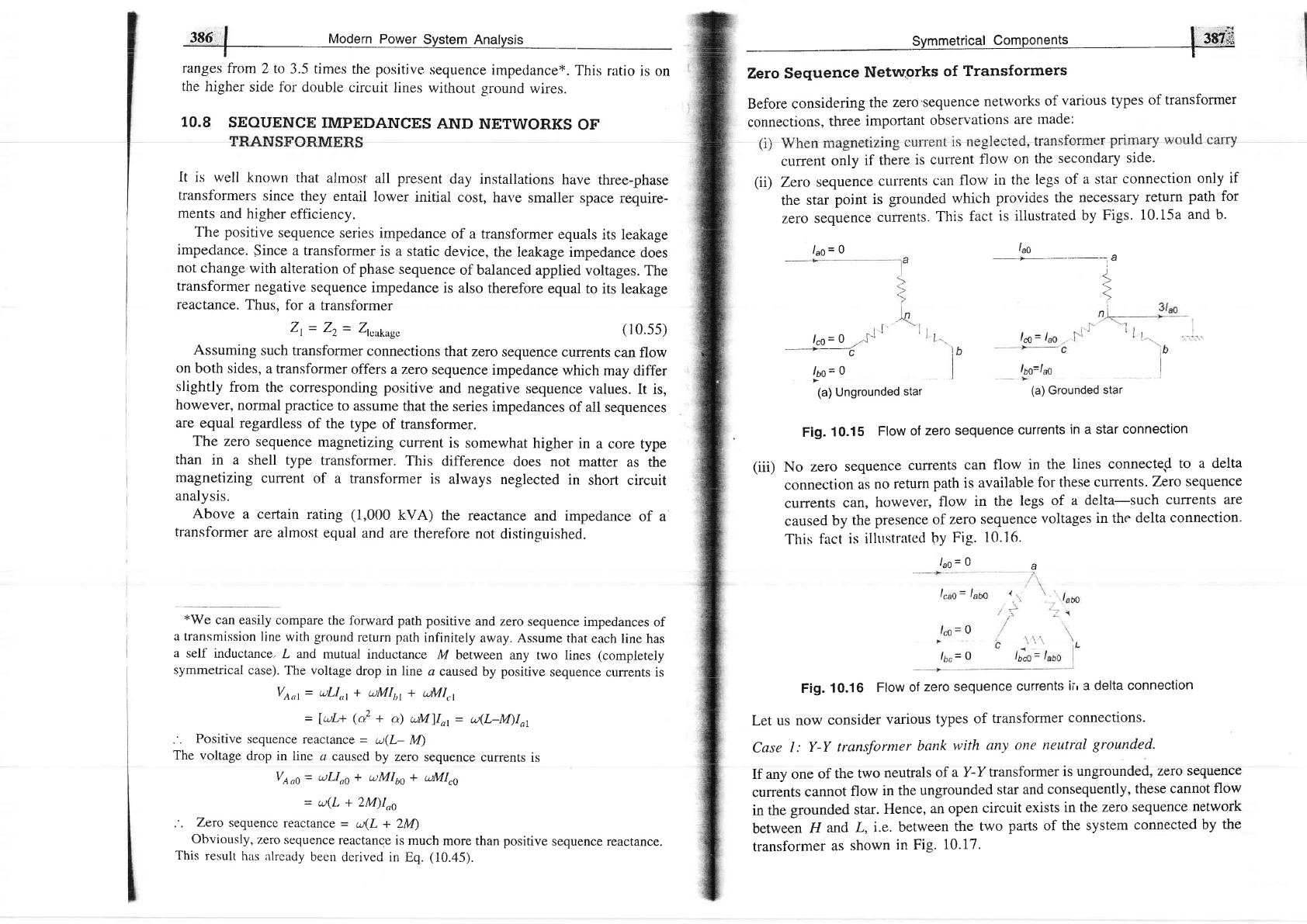
3Sd
I
Modern
Power
System
Anatysis
ranges
fromZ
to
3.5 times
the
positive
sequence
impedance*.
This
ratio
is on
the higher
side
for double
circuit
lines
without
ground
wires.
10.8
SEOUENCE
IMPEDANCES
AND
NETWORKS
OF
It is well
known
that
ahnosl
all
present
day
installations
have
three-phase
transformers
since they
entail
lower
initial
cost,
have
smaller
space
require-
ments
and higher
efficiency.
The positive
sequence
series
impedance
of
a transformer
equals
its leakage
impedance.
Since
a transformer
is a
static
device,
the leakage
impedance
does
not
change with
alteration
of
phase
sequence
of balanced
applied voltages.
The
transformer
negative
sequence
impedance
is also
therefore
equal
to its
leakage
reactance.
Thus.
for
a transformer
Zt= Zz=
Zr"ukug"
Symmetri
a
ter"
-"*"-
-"-t--t
"
transformers
the
zero'sequence
networks
of
various types
of transformer
important
observations
are
made:
current
only
if there
is cunent
florv
on
the
secondary
side.
(ii)
Zero
sequence
currents
can
flow
in the
legs
of
a star
connection
only if
the
star
point is
groundecl
which
provicies the
necessary
return
path
for
zero
sequence
culrents.
This
fact
is illustrated
by
Figs. 10.15a
and
b.
Before considering
connections,
three
(
r
0.55)
-
':o
__----,
a
{
.->
(a)
Grounded
star
Assuming
such
transformer
connections
that
zero
sequence cunents
can flow
on
both sides,
a transformer
offers a zero
sequence
impedance
which
may differ
slightly
from
the corresponding
positive
and negative
sequence
values.
It is,
however,
normal practice
to
assume that
the series
impedances
of all
sequences
are
equal regardless
of the
type
of transformer.
The
zero
sequence
magnetizing
current
is
somewhat
higher in
a core
type
than
in a
shell type
transformer.
This
difference
does not
matter
as the
magnetizing
curent
of a
transformer
is
always
neglected
in
short
circuit
analysis.
Above
a certain
rating
(1,000
kvA)
the
reactance
and
impedance
of a
transformer
are
almost
equal and
are therefore
not
distinguished.
*We
can easily
compare
the forward
path
positive
and zero
sequence
impedances
of
a transmission
line
with
ground
return
path
infinitely
away.
Assume that
each
line has
a self
inductance,
L and
mutual
inductance
M between
any two
lines
(completely
symmetrical
case). The voltage
drop in line
a
caused
by
positive
sequence
currents is
VAnt= uLlnr+
uMI,,r+
aMI,.1
-
[uL+
(&
+
a) aMllo,
=
a(L-tu|)Ior
Positive
sequence
reactance
=
a(L- fuI)
The voltage
drop
in line
a caused
by zero
sequence
currents
is
VAno= aLloo+
utMluo+
uMlrs
=
a(L + 2M)Ino
Zero
sequence
reactance
=
w(L + 2W
Obviously,
zero
sequence
reactance
is
much
more than
positive
sequence reactance.
This
result
has already
been
derived in
Eq.
(10.45).
r'l
/co
=
0
--f-'
/oo=
o
(a)
Ungrounded
star
Fig.
10.15
Flow
of
zero
sequence
currents
in a star
connection
(iii)
No
zero
sequence
currents
can
flow
in the
lines
connecte.d
to
a delta
connection
as
no
return
path is
available
for
these
culrents.
Zero sequence
currents
can,
howevet,
flow
in
the
legs
of a
delta-such
currents
are
caused
by
the
presence
of zero
sequence
voltages
in the
delta connection.
This fact
is illtrstrated
bY
Fig.
10.16'
/ao= 0
a
Fig.
10.16
Flow
of
zero Sequence
currents
ii', a
delta connection
Let us
now
consider
various
types
of
transformer
connections.
Case
I;
Y-Y
transformer
bank
with
any one
neutrttl
grounded.
If any one
of the
two
neutrals
of
a Y-Y
transformer
is ungrounded,
zero
sequence
currents
cannot
flow
in the
ungrounded
star
and
consequently,
these
cannot flow
in the
grounded
star.
Hence,
an open
circuit exists
in the
zero sequence
network
between
H
and
L,
i.e.
between
the
two
parts of
the system
connected
by
the
transformer
as
shown
in Fig.
10.17.
/ao=
0
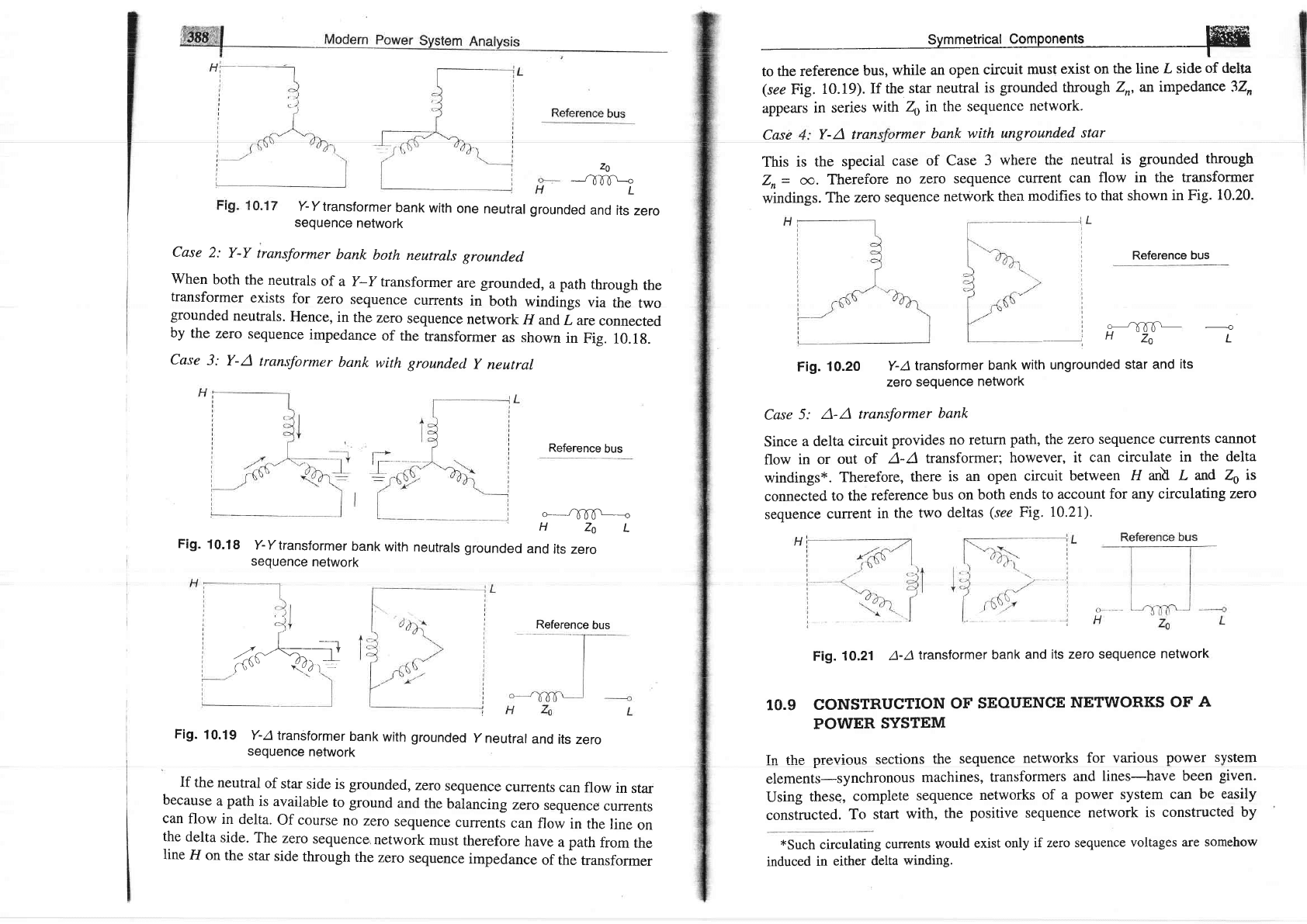
Zg
---tll
d---
L
Y-Ytransformer
bank
with
one
neutral
grounded
and
its
zero
sequence
network
Case
2:
Y-Y
transforrner
bank
both
neutrals
grounded
When
both
the
neutrals
of
a
Y-Y
transformer
are
grounded,
a
path
through
the
transformer
exists
for
zero
sequence
currents
in
both
windings
via
the
two
grounded
neutrals.
Hence,
in
the
zero
sequence
network
11and
L are
connected
by
the
zero
sequence
irnpedance
of
the
transformer
as
shown
in
Fig.
10.1g.
Case
3:
Y-A
transformer
bank
with grounded
y
neutral
Reference
bus
o---4TdL=-o
HZsL
Fig.
10.18
Y-Ytransformer
bank
with
sequence
network
neutrals grounded
and
its zero
Reference
bus
ffi
(see
Fig.
10.19).
If the
star
neutral
is
grounded
through
2,, an impedance 3Zn
appears
in series
with
Z,
in the
sequence
network-
Casb
Y-A
tran
rmer
bank
with
ungrounded
star
This
is the
special
case
of Case
3
where
the neutral
is
grounded
through
Zn
=
oo.
Thereiore
no
zero
sequence
curent can
flow in the
transformer
windings.
The zero
sequence
network
then modifies
to
that shown
in Fig.
10.20.
Reference
bus
"ifr6L
H2;
Fig.
10.20
Y-l
transformer
bank
with ungrounded
star and
its
zero
sequence
network
Case
5:
A-A
transformer
bank
Since
a delta
circuit
provides
no return
path,
the
zero
sequence
currents
cannot
flow
in or
out
of
A-A
transformer;
however,
it can
circulate
in
the delta
windings*.
Theretore,
there
is
an open
circuit
between
H anE L
and Zo
is
connected
to the
reference
bus
on both
ends to
account
for any circulating
zero
sequence
current
in
the two
deltas
(see
Frg.
10.2I).
Fig.
10.21
A-Atranstormer
bank
and
its zero sequence
network
10.9
CONSTRUCTION
OF
SEOUENCE
NETWORKS
OF
A
POWER
SYSTEM
In
the
previous
sections the
sequence
networks
for various
power
system
elements-synchronous
machines,
transformers
and
lines-have been
given.
Using
thesq,
complete
sequence
networks
of
a
power system can
be
easily
constructed.
To start
with,
the
positive sequence
network
is
constructed by
*Such
circulating
currents
would
exist only
if
zero sequence
voltages
are
somehow
induced
in
either
delta
winding.
{L
----------o
L
d-E-;1
a
---_.
^--r-
-I
Fig.
10.19
Y-1 transformer
bank
with
grounded
yneutral
and
its
zero
sequence
network
If
the
neutral
of
star
side
is
grounded,
zero
sequence
currents
can
flow
in
star
because
a
path
is
available
to ground
and
the
balancing
zero
sequence
currents
can
flow
in
delta.
Of course
no
zero
sequence
currents
can
flow
in
the line
on
the
delta
side.
The
zero
sequence
network
must
therefbre
have
a
path
from
the
line
1{
on
the
star
side
through
the
zero
sequence
impedance
of the
transformer
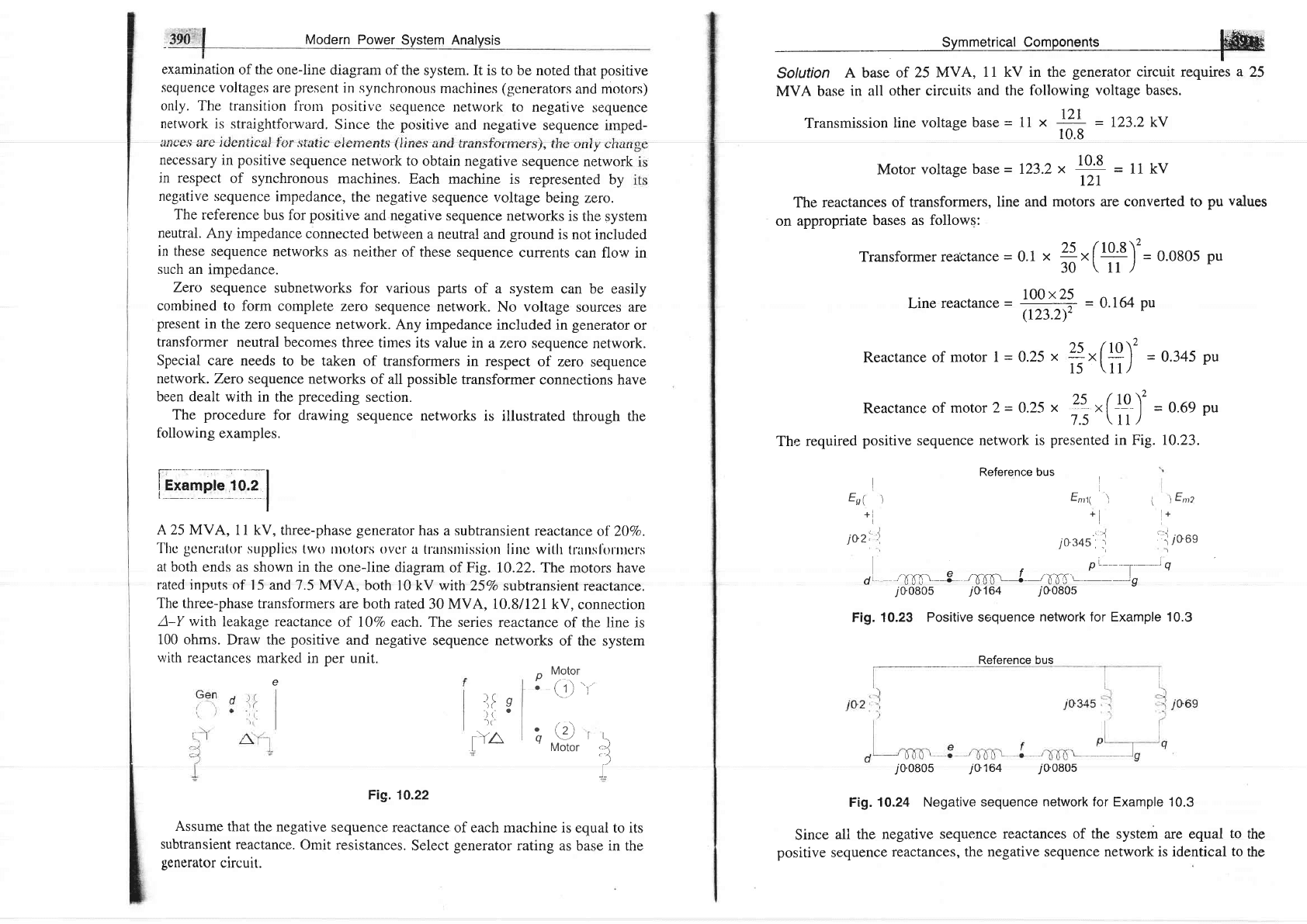
Modern Power
System Analysis
examination
of
the
one-line
diagrarn of the
system.
It is to be noted
that
positive
sequence
voltages
are
present
in synchronous
machines
(gcnerators
and motors)
only. The
transition li'orr-r positil'e
sequence
network
to negative
sequence
network is
straightforward,
Since the
positive
and negative
sequence irnped-
,)
\rrrrvD
qrtu
Lt otrJltrt
ttlvt Jrr, rrrv
LrltlJ vrrarr
neclessary
in
positive
sequence
network
to obtain negatit'e
sequence
network
in respect
of synchronous
machines.
Each machine
is
represented by
neg;ttive sequence
impedance,
the negative
sequence voltage
being
zero.
The reference
bus for positive
and
negative
sequence networks
is
the system
neutral. Any
impedance
connected
between a
neutral and
ground
is not included
in these
sequence
networks
as neither
of these sequence
currents
can flow in
such an
impedance.
Zero
sequence
subnetworks for
various
parts
of a system
can be easily
combined to
form complete
zero sequence
network.
No
voltage
sources
are
present
in
the zero
sequence network.
Any impedance
included
in
generator
or
transformer
neutral becomes
three tirnes its value in
a zero sequence
network.
Special care needs
to be taken
of transforners
in respect
of zero
sequence
network.
Zero sequence
networks
of all
possible
transformer connections
have
been dealt
with in the
preceding
section.
The
procedure
for drawing
sequence networks
is illustrated
through the
following examples.
f-"--
-
-:----'
r
Example
10.2
1
t______:_-l
A 25 MVA,
1l kV,
three-phase
generator
has a subtransient
reactance
of 20Vo.
Tlrc
gcrrcrittor
supplics
two rrtotors
ov0r'r,r transnrission
linc wiLh
traltslollrrcl's
at
both ends as
shown in the
one-line diagram
of Fig. I0.22.
The motors have
rated inptrts of
15 and 7.5 MVA,
both 10 kV
with 25Vo subtransient
reactance.
The three-phase
transformers
are both rated
30 MVA,
I0.8/L2I kV,
connection
A-Y with
leakage reactance
of 70Vo each.
The series
reactance
of
the
line is
100 ohms.
Draw the
positive
and negative
sequence networks
of the
system
with
reactances
marked in
per
unit.
e
ffi
MVA
base
in all
other circuits
and the following
voltage bases.
Transmission
line
voltase base
=
11
x
121
-
123.2 kY
10.8
Reactance
of motor
I
=
0.25
x
=
0.345
pu
Motor
voltage
base
=
123.2
x
++
=
11 kV
121
The reactances
of
transformers,
line and
motors are converted to
pu
values
on
appropriate
bases
as follows:
Transformer
reactance
=
0.1
x
=. f++)
=
0.0s05
pu
30
\ 11 /
Line
reacl
loo
x
25
:ance=
ffi
=o.164pu
2s /10\2
-xt-
|
15
\lll
The
Reactance of
motor
2
-
0.25
x
?1,
rf
-Lo
)t
=
0.69
pu
7.5 \ ll /
required
positive
sequence
network is
presented
in Fig. 10.23.
Reference bus
I
Es(
)
+l
ioz:
),
I
Enrt(
)
+l
I
.r:
t!
io345:
-r
i
)
Eara
l+
--,1
iio6e
t
p
u910'
'
(-t,
)
'r'
.
(2)
,
q\-/r\
'
Motor
,,1
I
It
s
'rt-
o
IYA
. P
-----r--'---
9
d
,-6
6X-L-g
,.I-6XU -,
"xfi
r-
-
In
i
oo8o5
j0'164
i
00805
Fig. 10.23 Positive
sequence
network for Example 10.3
Reference bus
i
0.0805
j4164
loo8o5
Fig.
10.24 Negative sequence
network for Example
10.3
Since
all the negative
sequence reactances
of the
system are equal
to
the
positive sequence
reactances, the
negative sequence network is
identical
to
the
Fig. 10.22
Assume
that
the negative
sequence reactance
subtransient
reactance.
Omit resistances.
Select
generator
circuit.
of each machine
is
generator
rating
as
equal to its
base in the
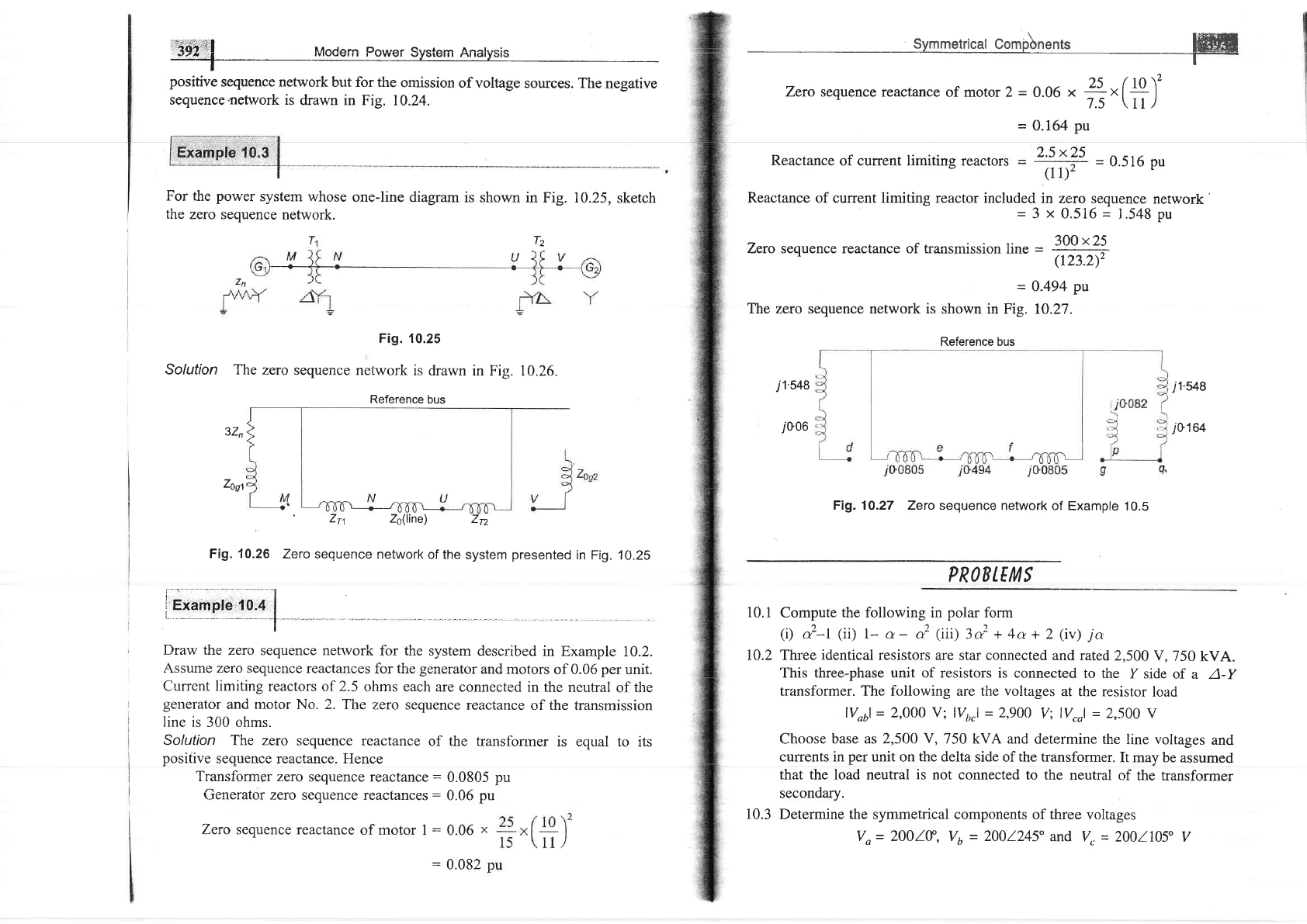
'
rti..;;:1
.
::i.l
3,42'l l-4odern
Pov"'ei'
Svstem Analvsis
positive
sequence network
but for the
omission
of voltage
sources.
The negative
sequence
network
is
drawn in
Fig. 10.24.
For the power
system whose
one-line
diagram
is shown
in Fig. 10.25,
sketch
the
zero sequence
network.
Fig. 10.25
Solution The
zero
sequence network
is
drawn in Fig.
10.26.
Reference
bus
Zrt
Z6(line)
272
Fig. 10.26
Zero sequence
network
of the
system
presented
in Fig.
10.25
i--i----
-
_- *-;
1
Example 10.4
|
-*-"
1
Draw the zero
sequence netrvork
for the
system
described in Example
10.2.
Assume zero
sequence reactances
for the
generator
and
motors
of 0.06
per
unit.
Current limiting reactors
of
2.5
ohms each
are connected in the
neutral
of
the
generator
and motor No. 2.
The zero
sequence reactance
of the transmission
line is
300 ohms.
Solution The zero
sequence
reactance
of the transfonner
is equal
to its
positive
sequence reactance.
Hence
Transformer zero
sequence reactance
:
0.0805
pu
Generator zero seqllence
reactances:
0.06
pu
Zero sequence
reactance
of motor 1
:
0.06
x
T2
T1
32n
Zost
symmetricat
compblents
ffi
-------_-1
Zero sequence
reactance of
motor
2
-
0.06
"
+.
(i+)'
=
0.164
pu
Reactance
of current limiting reactors
=
''.1.i3t
=
0.516
pu
(1
1)',
Reactance
of current limiting reactor included
in zero sequence
network'
=
3
x
0.516
--
1.548
pu
Zero sequence
reactance of transmission line
=
ry:21
(r23.D2
=
0.494
pu
The zero sequence
network
is
shown in Fig.
10.27.
j1-548
io06
Fig. 1O.27 Zero sequence
network
of Example
10.5
PROB
IEIvIS
10.1
Compute
the following in
polar
form
(i)
o2-t
1ii;
I- a
-
"?
(iii)
3 d
+ 4cy
+ 2
(iv)
ja
10.2 Thlee identical resistors are star connected
and rated
2,500 V,
750
kVA.
This thre.e-phase unit of resistors is
connected
to the
I side
of
a A-Y
transformer.
The following
are the
voltages
at the
resistor
load
lVo6l
=
2,000 Y;
lVu,l
=
2,900
V; lV,ol
=
2,500
V
Choose
base as 2,500
V,
750 kVA
and determine
the
line voltages
and
currents in
per
unit on
the
delta side of the transforrner.
It may
be
assumed
that the load neutral
is
not connected
to the neutral
of
the transformer
secondary.
10.3
Determine
the symmelrical components
of three voltages
Vo= 2001ff,
Vt
=
2001245"
and
V,
=
2001105'
y
Reference bus
j1.il8
jo164
26(line)
:
0.082
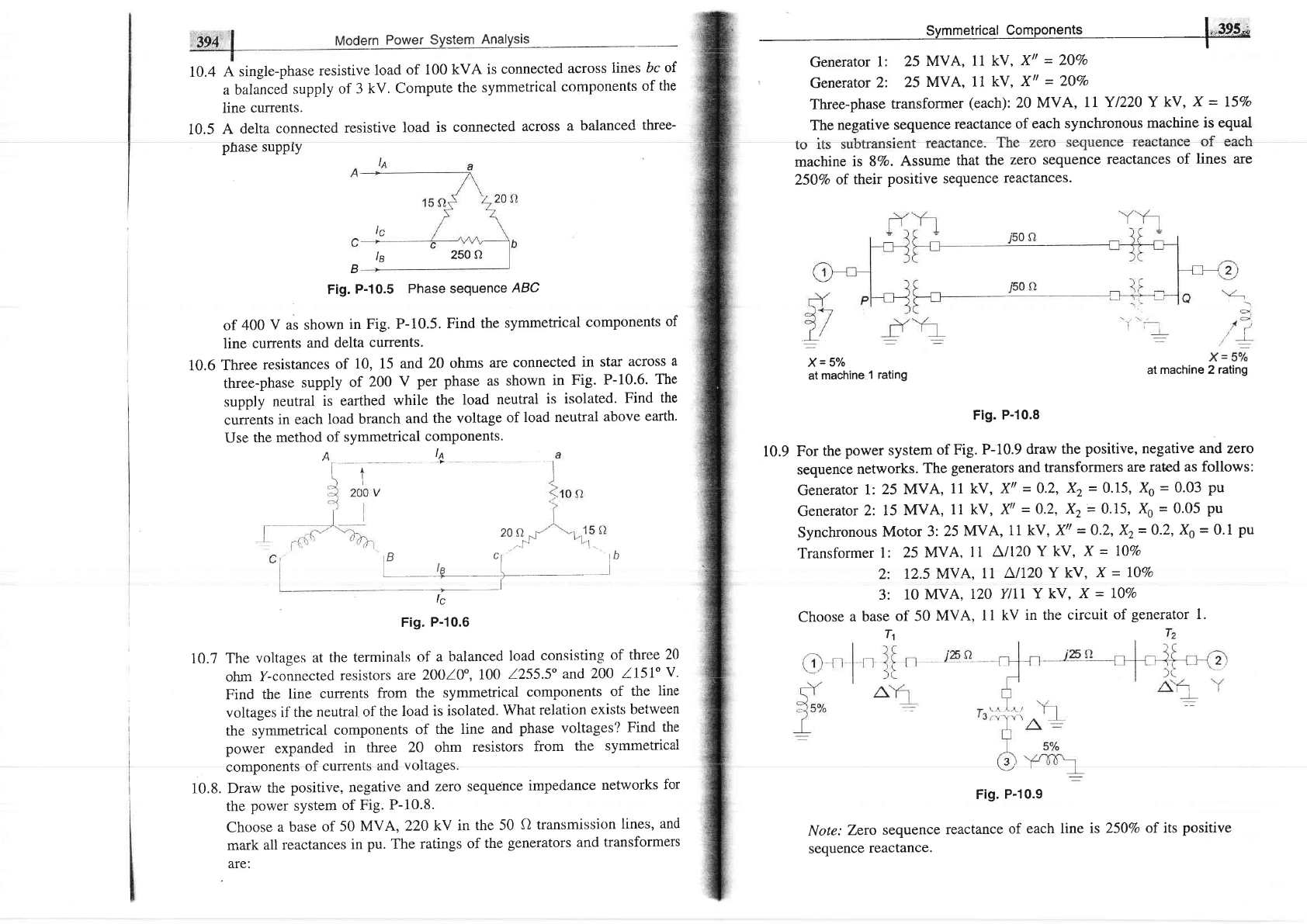
Power
System
Analysis
10.4
A
single-phase
resistive
load
of 100
kVA
is
connected
across
iines
bc of
a balanced
supply
of
3 kV.
Compute
the symmetrical
components
of the
line
currents.
10.5
A delta
connected
resistive
load
is connected
across
a
balanced
three-
pnase
supply
250
f)
B
Fig.
P-10.5
Phase
sequence
ABC
of
400
V
as shown
in Fig.
P-10.5.
Find the
symmetrical
components
of
line
cunents
and
delta
currents.
10.6
Three
resistances
of
10, 15
and
2O ohms
are
connected
in star
across
a
three-phase
supply
of
200
V
per
phase as shown
in
Fig.
P-10.6.
The
supply
neutral
is
earthed
while
the
load
neutral
is isolated.
Find
the
currents
in
each
load
branch
and
the
voltage
of
load neutral
above
earth.
Use
the method
of symmetrical
components'
la
Ir
"-"*'
"
'
Generator
2:
25
MVA,
11
kV,
Xtt
=
ZOVo
Three-phase
transformer
(each):
20 MVA,
ll
Y1220 Y
kV,
X
=
I5Vo
The
negative
sequence
reactance
of
each synchronous
machine
is equal
machine
is 8Vo.
Assume
that the
zero sequence
reactances
of
lines are
25OVo
of
their
positive sequence
reactances.
tB
c1
tb
I-
te
_L__
_l
1--
ls
Fig.
P-10.6
10.7
The
voltages
at the
terminals
of a
balanced
load
consisting
of three
20
ohm
X-connected
resistors
arc
2OO4O",
100
1255.5'and
200
llsf
V.
Find
the
line
currents
from
the symmetrical
components
of
the
line
voltages if the
neutral
of
the load
is isolated.
What
relation
exists
between
the
syrnrnetrical
components
of
the line
and
phase voltages'/
Find
the
power expanded
in
three 20
ohm
resistors
from
the
symmetrical
components
of
currents
and
voitages.
10.8.
Draw
the
positive, negative
and
zero sequence
impedance
networks
for
the
power system
of Fig.
P-10.8.
Choose
a base
of
50 MVA,
220 kV
in
the 50
0 transmission
lines,
and
mark
all
reactances
in
pu.
The
ratings
of
the
generators and
transformers
are:
X
=
5o/o
at
machine,l
rating
at
machine 2
rating
Fig.
P-10.8
For
the
power system
of Fig.
P-10.9
draw
the
positive, negative
and
zero
sequence
networks.
The
generators and
transformers
are
rated as follows:
Generator
l:25
MVA,
11 kV,
Xtt=0.2,
X2
=
0.15,
Xo
=
0.03
pu
Generator
2: 15
MVA,
11 kV,
Xt
=0.2,
Xz= 0.15,
X0
=
0.05
pu
Synchronous
Motor
3:
25
MVA,
11 kV,
Xt
=
0-2,
Xz= 0-2,
Xo
=
0.1
pu
Transformer
l:
25
MVA,
I 1
Lll20
Y
kV, X
=
IIVo
2:
12.5
MVA,
11
LlI20
Y kV,
X
=
l07o
3:
10
MVA,
I2O
Ylll
Y kV,
X
-
IjVo
Choose
a base
of 50
MVA,
I
I kV
in the
circuit
of
generator
l.
Fig.
P-10.9
Note:
Zero
sequence
reactance
of
each line is
250Vo
of its
positive
sequence
reactance.
r0.9
'0.:-"t
T1
\7
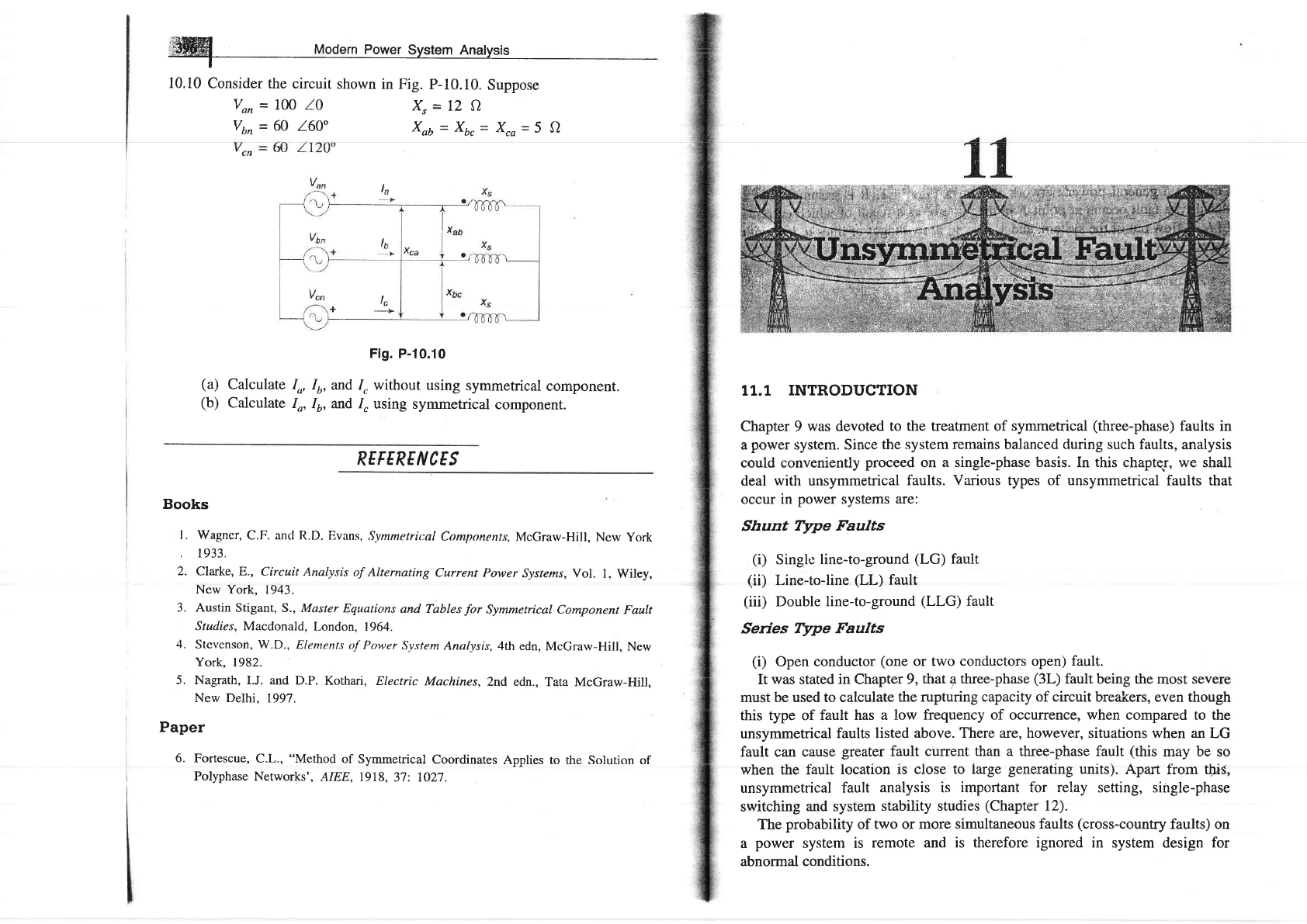
j,,W
voo"in
po*",,
syrt"r Rn"tu"i,
10.10
Consider the circuit
shown in Fig.
P-10.10.
Suppose
Vo,
=
L00
l0
vbn
=
60 160
Xr=12
Q
Xob=Xbr=X*=5d)
Fig.
P-10.10
16,
and 1, without
using
symmetrical
component.
16, and 1"
using
symmetrical
component.
REFERE
N CES
Books
l. wagncr,
c.F.
and
R.D.
Evans,
symmetrit:al
componenfs,
McGraw-Hill,
Ncw
york
,
1933.
2.
Clarke, E.,
Circuit Analysis
of Alternating
Current Power
Systems,
Vol. 1.
Wiley,
Ncw
York, 1943.
3. Austin
Stigant, 5., Master
Equations
and Tables
for
Symmetrical
Component
Fault
Studies, Macdonald,
London, 1964.
4.
stcvenson, w.D.,
Elcments
oJ' Power
Sy.stem Analysis,4th
edn,
McGraw-Hill,
New
York, 1982.
5. Nagrath,
I.J. and
D.P. Kothai,
Electric
Machines,2nd
edn.,
Tata McGraw-Hill,
New Delhi,
1997.
Paper
6. Fortescue,
C.L.,
"Method
of
Symmetrical
Coordinates
Aonlies to the Solution of
Polyphase
Networks',
AIEE, 1918,37:
1O27.
II.I
INTRODUCTION
Chapter 9
was devoted
to the treatment of
symmetrical
(three-phase)
faults in
a
power
system. Since
the system remains balanced
during
such faults,
analysis
could conveniently
proceed
on a single-phase basis. In this chapter, we shall
deal with unsymmetrical
faults. Various
types
of
unsymmetrical faults that
occur
in
power
systems
are:
Shunt
Wpe
Faults
(i)
Single line-to-ground
(LG)
fault
(ii)
Line-to-line
(LL)
fault
(iii)
Double
line-to-ground
(LLG)
fault
Series
Type Faults
(i)
Open
conductor
(one
or two conductors open)
fault.
It was stated in Chapter
9,
that
a
three-phase
(3L)
fault being
the most severe
must
be used to calculate
the rupturing
capacity of circuit
breakers, even though
this type of fault
has a
low frequency of occurrence, when compared to the
unsymmetrical
faults listed
above. There are, however, situations when an
LG
fault can cause
greater
fault
current than a three-phase fault
(this
may be so
when the fault location
is close
to large
generating
units).
Apart fiom tliS,
unsymmetrical
fault
analysis
is
important for relay setting, single-phase
switching
and system
stability
studies
(Chapter
12).
The
probability
of
two or more
simultaneous faults
(cross-country
faults) on
a
power
system is
remote
and is therefore ignored in
system design
for
abnormal conditions.
(a)
Calculate
Io,
(b)
Calculate
Io,
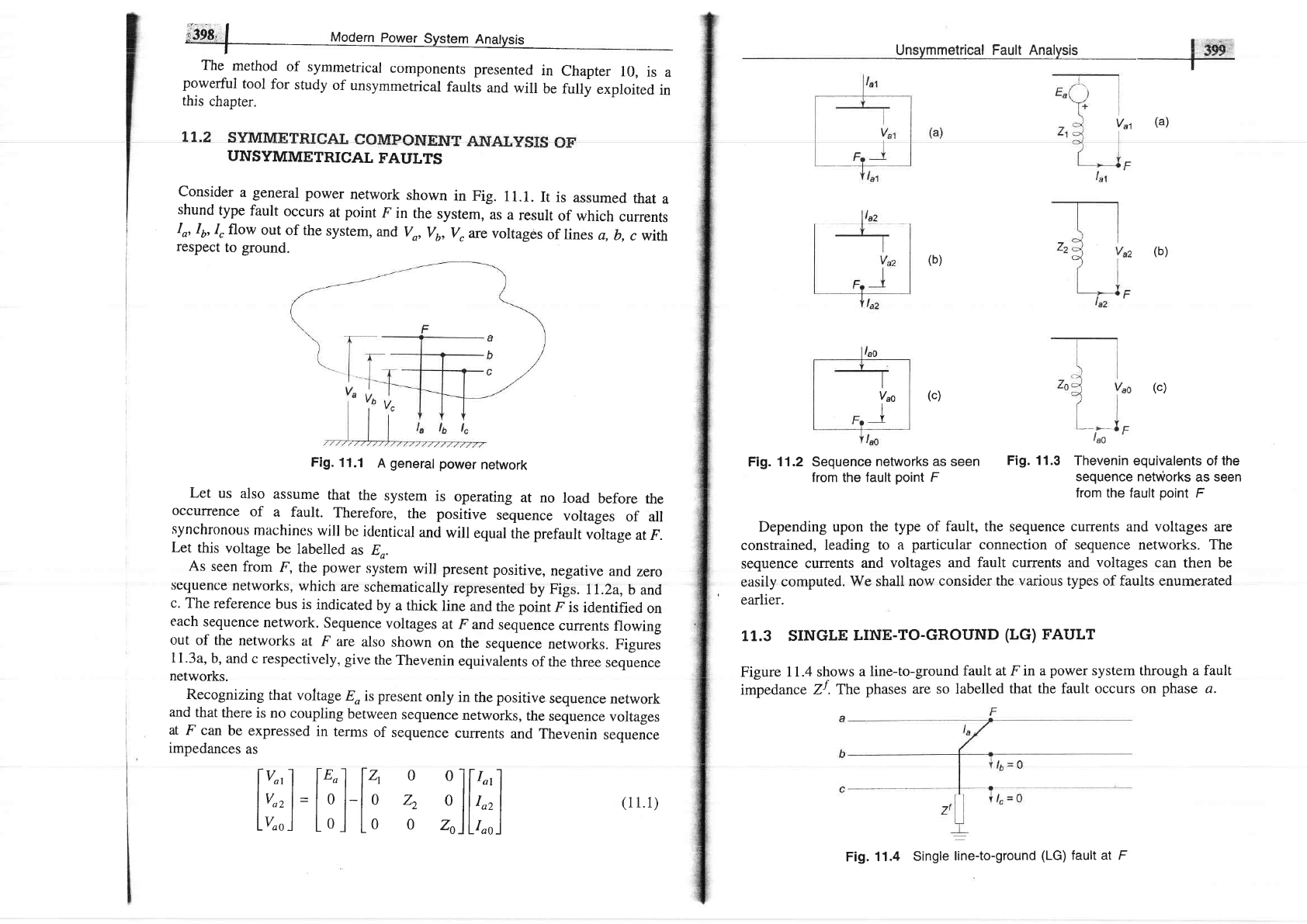
*g9,S.
I
Modern
power
System
Anatysis
The
method
of
symmetricar
cclmponents
presented
in
chapter
10,
is
a
powerful
tool
for
study
of
unsymmetrical
faults
and
witl
be
fully
exploited
in
this
chapter.
UNSYMMETRICAL
FAULTS
Consider
a general
power
network
shown
in Fig.
11.1.
It is
assumed
that
a
shund
type
fault
occurs
at
point
F
in
the
system,
is a
result
of which
currenm
Io,
16,
/,
flow
out
of
the
system,
and
vo,
v6,
v"are
voltages
of
lines
a,
b,
c with
respect
to
ground.
Fig.
11.1
A
general
power
network
Let
us
also assume
that
the
system
is
operating
at no
load
before
the
occurrence
of a
fault.
Therefore,
the
positive
sequence
voltages
of
all
synchronous
machines
will
bc
identical
and
will
equal
the
prefault
voltage
at F.
Let
this
voltage
be
labelled
as
Eo.
As
seen
from
F,
the
power
system
will present
positive,
negative
and
zero
sequence
networks,
which
are
schematically
represented
by
Figs.
Il.2a,
b
and
c.
The
reference
bus
is
indicated
by
a
thick
line
and
the point
F
is
identified
on
each
sequence
network.
Sequence
voltages
at F
and
sequence
currents
flowing
out
of the
networks
at
F
are
also
shown
on
the
sequence
networks.
Figures
1 1.3a,
b, and
c respectively,
give
the
Thevenin
equivalents
of the
three
sequence
networks.
Recognizing
that
voltage
Eo
is
present
only
in
the
positive
sequence
network
and
that
there
is no
coupling
between
sequence
networks,
the
sequence
voltages
at
F
can
be expressed
in
terms
of
sequence
currents
and
Thevenin
sequence
impedances
as
Unsymmetrical
Fault Analysis
Fig.
11 .2
Sequence
networks as seen
Fig. 11.3
Thevenin equivalents
of
the
from the fault
point
F
sequence netWorks
as
seen
from the fault
point
F
Depending upon
the type
of fault, the sequence cunents
and
voltages
are
constrained,
leading to
a
particular connection
of sequence networks. The
sequence
curents
and
voltages and fault currents and
voltages
can
then
be
easily
computed.
We
shall now
consider the
various
types of faults enumerated
earlier.
11.3 STNGIE
LINE-TO-GROUND
(tG)
FAULT
Figure
11.4 shows
a line-to-ground
fault at F in a
power
system
through
a fault
impedance
ZI.
The
phases
are so labelled
that the fault occurs on
phase
a.
Fig.
11.4
Single
line-to-ground
(LG)
fault at F
(a)
Vat
(b)
(b)
(c)
(c)
lao
1r",1 lt"1 lt,
0
o
l|-r",'l
lr",l=lol-l
o
22
oll,*l
Lv"o)
Lol
Io
o
zo)lr"o)
Vao
_l
(11.1)
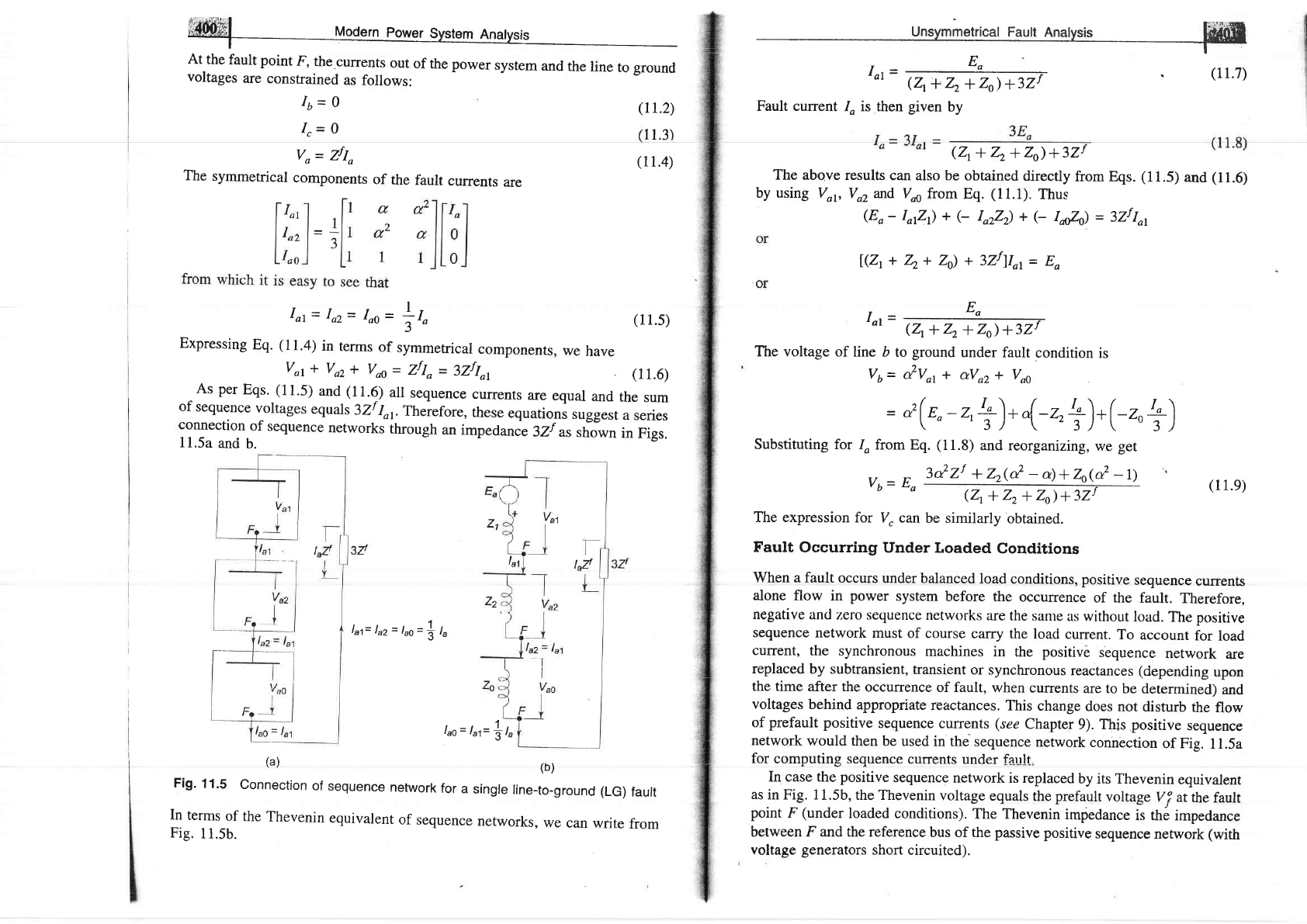
At
the
fault point
F,
the
currents
out
of the power
system
and
the
line
to
ground
voltages
are
constrained
as
follows:
Unsvmmetrical
Fault
Anatvsis
fffiH
r=Eo
'at
(zr
*
zz
*
z)
+3zr
Fault current
/o is
then
given
by
Iu=
o
Ir=
0
vo
=
zllo
The
symmetrical
components
of
the
fault
currents
are
Expressine
Eq
,r':l;
,';',.*1;,ij;.*.ar
componenrs,
we
have
Vot
*
Voz
*
Voo
=
ZfIo
=
3zflor
As per
Eqs.
(11.5)
and
(11.6)
all
sequence
currents
are
equal
and
the
sum
of
sequence
voltages
equals
3zf
lot
Theiefore,
these
equations
suggest
a
series
connection
of
sequence
networks
through
an
impedan
ie
3zf
ut
rrio"*n
in
Figs.
11.5a
anci
b.
la,t=
laz
=
t"o=
t
h
l"s=
I,,1=
t
t,
(zr
*
zz
*
zo)
+32
The above
results
can also be
obtained
directly
from Eqs.
(11.5)
and
(11.6)
by using Vop
Vo2 and
Voe from
Eq.
(11.1).
Thus
(Eo-
IolZ)
+
(-
IorZr)
+
(-
I"&d
=
3Zf
lot
I(4+
4+
Zo) +
3zfllor=
Eo
Ior
=
(zr
*
zz
-t
Z)
+3zr
The voltage
of line
b to
ground
under
fault
condition
is
Vu=
&Vor+
aVo2* Voo
=
o,2
(n'
-
^
+)*
4-',+).
(-"
+)
Substituting for
/o from Eq.
(11.8)
and reorganizing,
we
ger
3rl2 zr
+
Z2(&
-
a)
+
zo(&
-
D
(Zr*22+Zo)+3Zt
be similarly
obtained.
(rr.2)
1
1.3)
(11.4)
(11.5)
(11.6)
. (11.7)
(11.e)
Eo
Va=
Eo
The expression
for
V, can
/a\
(b)
Fig'
11'5
Connection
of
sequence
network
for
a
single
line-to-ground
(LG)
fault
In
terms
of
the
Thevenin
equivalent
of
sequence
networks,
we
can
write
from
Fig.
11.5b.
Fault
Occurring
Under
Loaded
Conditions
When a fault
occurs
under
balanced
load
conditions,
positive
sequence
currents
alone flow
in
power
system
before the
occurrence
of the
fault.
Therefore,
negative and
zero sequence
networks
are the
sanle
as without
loacl.
The positive
sequence
network
must
of course
carry
the load
current.
To
account
for
load
current,
the
synchronous
machines
in
the
positive
sequence
network
are
replaced
by subtransient,
transient
or synchronous
reactances
(depending
upon
the time
after the
occulTence
of fault,
when
currents
are
to be
determined)
and
voltages
behind
appropriate
reactances.
This
change
does
not disturb
the
flow
of
prefault
positive
sequence
currents
(see
Chapter
9). This positive
sequence
network
would
then be
used in the
sequence
network
conhection
of Fig.
11.5a
for
computing sequence currents
under
fault
In case the
positive
sequence
network
is replaced
by its Thevenin
equivalent
as
in Fig. 11.5b,
the Thevenin
voltage
equals
the
prefault
voltage
Vi atthe
fault
point
F
(under
loaded
conditions).
The
Thevenin
impedance
is th6
impedance
between F and the reference
bus of the
passive
positive
sequence
network
(with
voltage
generators
short
circuited).
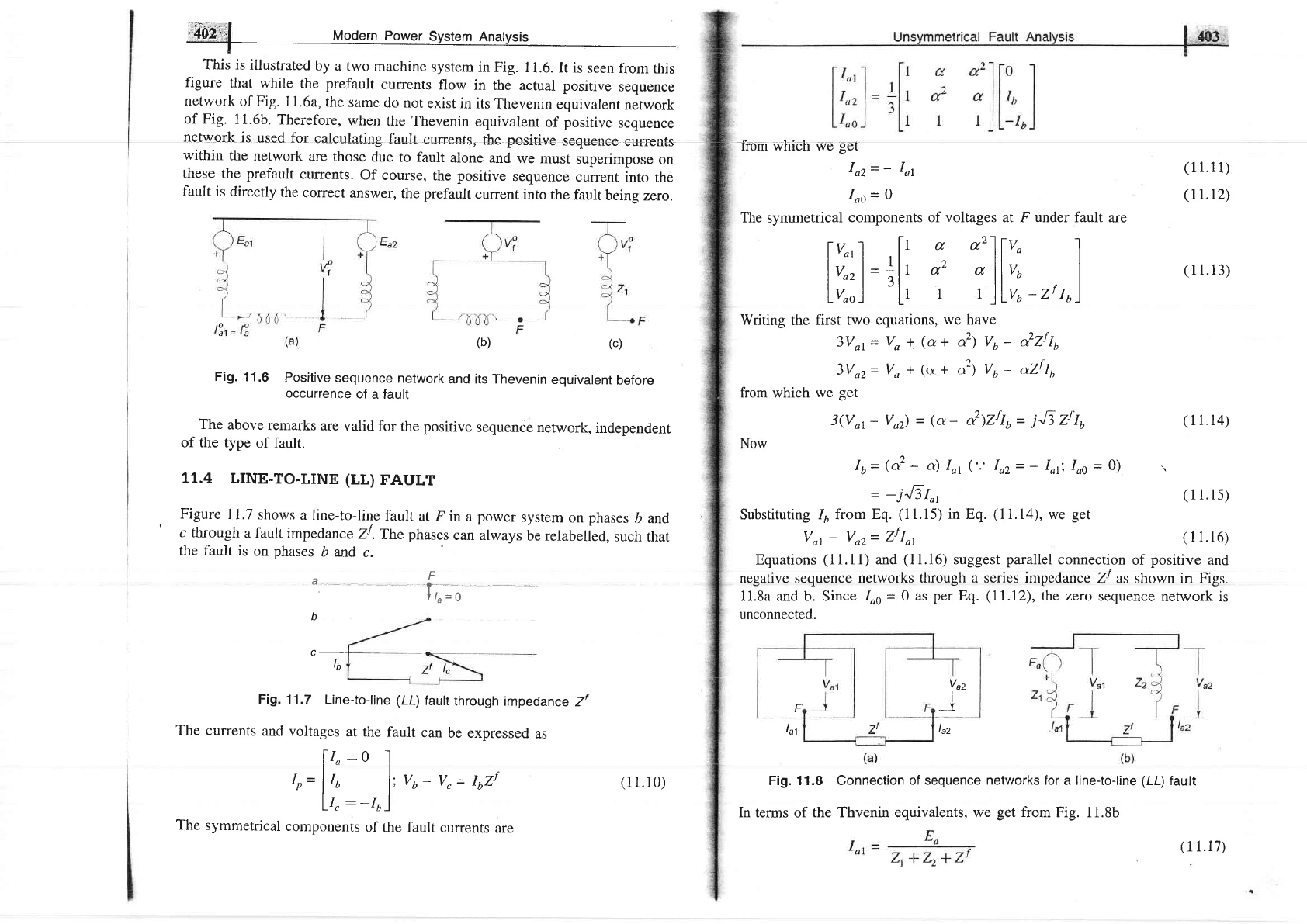
i'4ot',,1
Modern
Po@is
fni, i,
illustratecl
by
a two
machine
system
in
Fig. 11.6.
It is seen
fiom this
figure
that while
the
prefault
currents
flow
in
the actual
positive
sequence
network
<lf Fig.
11.6a,
the
samc
do
not
exist
in its
Thevenin
equivalent
network
of Fig'
11.6b.
Therefore,
when
the
Thevenin
equivalent
of
positive
sequence
network
is
used
fot
calculatlng
fault
eurre+ts,
the
positive
sequenee
eurrents
within
the
network
are
those
due
to fault
alone
and
we
must
superimpose
on
these
the
prefault
currents.
Of course,
the
positive
sequence
current
into the
fault
is
directly
the
correct
answer,
the prefault
current
into
the
fault
being
zero.
(c)
Fig.
11.6
Positive
sequence
network
and its Thevenin
equivalent
before
occurrence
of
a fault
The
above
remarks
are
valid
for
the positive
sequenie
network,
independent
of the type
of fault.
t7.4
LrNE-TO-LrNE
(LL)
FAULT
Figure
I
1.7
shows
a line-to-line
fault
at
F in
a
power
system
on
phases
b
and
c
through
a
fault
impedance
Zf
. The
phases
can always
be relabelled,
such
that
the
fault is
on
phases
b
md
c.
b
l6
Fig.
11.7
Line-to-line (Lt)
fault
through
impedance
Z/
fault
can
be expressed
as
(b)
The currents
and
voltages
at the
[1":o
I
Io=
lIu
lI,
:
-Ir
The
symmetrical
components
of
I
l,
t'
_i
the
Vo-
Vr=
IoZf
fault
currents
are
(11.10)
from
whlch
we
get
Io2=
-
Iol
1.,0
=
0
The
symmetrical
components of
voltages
at F under fault
are
Writing the
3voz=
v,
+
(tr
+
,l)
vo
-
ull Iu
from which
we
get
3(va- voz)
-
(a
-
&1zrtu
-
iJi
y'
to
Now
I
v,,f
, [t
a o'fl''
I
lr",l=ilt
a2
"llr,
LV"o)
Lr
1 I
lL",
-zr
ra)
first
two
equations,
we
have
3vot= vo
+
(a+
&) vu
-
&zftu
(11.11)
(11.12)
(11.13)
(
1 1.14)
16=
(&
-
a)
Iot
(:
Ioz=
-
Iot, 1oo
=
0)
.r
=
-
jJt
I"r
(
11.15)
Substituting
16 from
Eq.
(11.15)
in Eq.
(11.14),
we
get
Vot
-
Voz=
Zf Iot
(11.16)
Equations
(11.11)
and
(11.16)
suggest
parallel
connection
of
positive
and
negative
sequence
networks through a series intpedance
V as
shown in
Figs.
11.8a and b. Since
loo= 0 as
per
Eq.(11.12),the zero
sequence
network
is
unconnected.
Vaz
_1
laz
Fig. 11.8 Connection
of sequence
networks
for
a
line-to-line
(LL)
fault
In terms
of
the Thvenin equivalents, we
get
from
Fig. 11.8b
F
lat
(
1 1.17)
